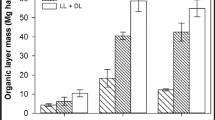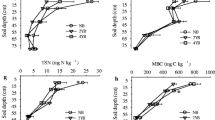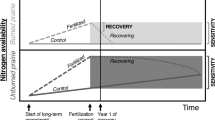Abstract
Post-fire litter layers are composed of leaves and woody debris that predominantly fall during or soon after the fire event. These layers are distinctly different to pre-fire litters due to their common origin and deposition time. However, heterogeneity can arise from the variable thermal conditions in the canopy during fire. Therefore, in this study, we used thermally altered pine needles (heated to 40 °C, 150 °C, 260 °C and 320 °C for 1 h) in a laboratory incubation study for 43 days. These samples were measured for respiration throughout and extracted for DNA at the experiment’s end; soil ribosomal RNA was analysed using Illumina sequencing (16S and internal transcribed spacer amplicons). The addition of pine needles heated to 40 °C or 150 °C caused a substantial shift in community structure, decreased alpha diversity and significantly increased soil respiration relative to the control treatment. In contrast, pine needles heated to 260 °C or 320 °C had little effect on microbial community structure or soil respiration. These results indicate that highly thermally altered needles are not microbially decomposed during the first 43 days of exposure and therefore that biomass temperature may have significant effects on post-fire litter decomposition and carbon flux. This research outlines an important knowledge gap in forest fire responses that may affect post-fire carbon emission estimates.




Similar content being viewed by others
References
Alexis MA, Rasse DP, Rumpel C, Bardoux G, Péchot N, Schmalzer P, Drake B, Mariotti A (2007) Fire impact on C and N losses and charcoal production in a scrub oak ecosystem. Biogeochemistry 82:201–216. https://doi.org/10.1007/s10533-006-9063-1
Alexis MA, Rumpel C, Knicker H, Leifeld J, Rasse D, Péchot N, Bardoux G, Mariotti A (2010) Thermal alteration of organic matter during a shrubland fire: a field study. Organic Geochemistry 41:690–697. https://doi.org/10.1016/j.orggeochem.2010.03.003
Baldock JA, Smernik RJ (2002) Chemical composition and bioavailability of thermally altered Pinus resinosa (red pine) wood. Organic Geochemistry 33:1093–1109
Schmidt MWI, Noack AG (2000) Black carbon in soils and sediments: analysis, distribution, implications, and current challenges. Global Biogeochemical Cycles 14:777–793. https://doi.org/10.1029/1999GB001208
Merino A, Chávez-Vergara B, Salgado J, Fonturbel MT, García-Oliva F, Vega JA (2015) Variability in the composition of charred litter generated by wildfire in different ecosystems. Catena 133:52–63. https://doi.org/10.1016/j.catena.2015.04.016
Bååth E, Frostegård Å, Pennanen T, Fritze H (1995) Microbial community structure and pH response in relation to soil organic matter quality in wood-ash fertilized, clear-cut or burned coniferous forest soils. Soil Biology and Biochemistry 27:229–240
Certini G (2005) Effects of fire on properties of forest soils: a review. Oecologia 143:1–10. https://doi.org/10.1007/s00442-004-1788-8
Holden SR, Treseder K (2013) A meta-analysis of soil microbial biomass responses to forest disturbances. Frontiers in Microbiology 4. https://doi.org/10.3389/fmicb.2013.00163
González-Pérez JA, González-Vila FJ, Almendros G, Knicker H (2004) The effect of fire on soil organic matter—a review. Environment International 30:855–870. https://doi.org/10.1016/j.envint.2004.02.003
Fernandez I, Cabaneiro A, Carballas T (2001) Thermal resistance to high temperatures of different organic fractions from soils under pine forests. Geoderma 104:281–298. https://doi.org/10.1016/S0016-7061(01)00086-6
Keiluweit M, Nico PS, Johnson M, Kleber M (2010) Dynamic molecular structure of plant biomass-derived black carbon (biochar). Environmental Science and Technology 44:1247–1253. https://doi.org/10.1021/es9031419
Knicker H, Hilscher A, González-Vila FJ, Almendros G (2008) A new conceptual model for the structural properties of char produced during vegetation fires. Organic Geochemistry 39:935–939. https://doi.org/10.1016/j.orggeochem.2008.03.021
Alexis MA, Rasse DP, Knicker H, Anquetil C, Rumpel C (2012) Evolution of soil organic matter after prescribed fire: a 20-year chronosequence. Geoderma 189–190:98–107. https://doi.org/10.1016/j.geoderma.2012.05.003
Fernandes PM, Vega JA, Jiménez E, Rigolot E (2008) Fire resistance of European pines. Forest Ecology and Management 256:246–255. https://doi.org/10.1016/j.foreco.2008.04.032
Mabuhay JA, Isagi Y, Nakagoshi N (2006) Wildfire effects on microbial biomass and diversity in pine forests at three topographic positions. Ecological Research 21:54–63. https://doi.org/10.1007/s11284-005-0094-1
Rodríguez J, González-Pérez JA, Turmero A, Hernández M, Ball AS, González-Vila FJ, Enriqueta Arias M (2017) Wildfire effects on the microbial activity and diversity in a Mediterranean forest soil. Catena 158:82–88. https://doi.org/10.1016/j.catena.2017.06.018
Muqaddas B, Zhou X, Lewis T, Wild C, Chen C (2015) Long-term frequent prescribed fire decreases surface soil carbon and nitrogen pools in a wet sclerophyll forest of Southeast Queensland, Australia. Science of the Total Environment 536:39–47. https://doi.org/10.1016/j.scitotenv.2015.07.023
Badía D, López-García S, Martí C, Ortíz-Perpiñá O, Girona-García A, Casanova-Gascón J (2017) Burn effects on soil properties associated to heat transfer under contrasting moisture content. Science of the Total Environment 601–602:1119–1128. https://doi.org/10.1016/j.scitotenv.2017.05.254
Wang QK, Zhong MC, Wang SL (2012) A meta-analysis on the response of microbial biomass, dissolved organic matter, respiration, and N mineralization in mineral soil to fire in forest ecosystems. Forest Ecology and Management 271:91–97. https://doi.org/10.1016/j.foreco.2012.02.006
Stirling E, Macdonald LM, Smernik RJ, Cavagnaro TR (2019) Post fire litters are richer in water soluble carbon and lead to increased microbial activity. Applied Soil Ecology 136:101–105. https://doi.org/10.1016/j.apsoil.2018.12.021
Bonanomi G, Incerti G, Abd El-Gawad AM, Cesarano G, Sarker TC, Saulino L, Lanzotti V, Saracino A, Rego FC, Mazzoleni S (2018) Comparing chemistry and bioactivity of burned vs. decomposed plant litter: different pathways but same result? Ecology 99:158–171. https://doi.org/10.1002/ecy.2053
Pérez-Valera E, Goberna M, Faust K, Raes J, García C, Verdú M (2017) Fire modifies the phylogenetic structure of soil bacterial co-occurrence networks. Environmental Microbiology 19:317–327. https://doi.org/10.1111/1462-2920.13609
Sun H, Santalahti M, Pumpanen J, Köster K, Berninger F, Raffaello T, Jumpponen A, Asiegbu FO, Heinonsalo J (2015) Fungal community shifts in structure and function across a boreal forest fire chronosequence. Applied and Environmental Microbiology 81:7869–7880. https://doi.org/10.1128/AEM.02063-15
Rodríguez J, González-Pérez JA, Turmero A, Hernández M, Ball AS, González-Vila FJ, Arias ME (2018) Physico-chemical and microbial perturbations of Andalusian pine forest soils following a wildfire. Science of the Total Environment 634:650–660. https://doi.org/10.1016/j.scitotenv.2018.04.028
Sun H, Santalahti M, Pumpanen J, Köster K, Berninger F, Raffaello T, Asiegbu FO, Heinonsalo J (2016) Bacterial community structure and function shift across a northern boreal forest fire chronosequence. Scientific Reports 6. doi: https://doi.org/10.1038/srep32411
Liu X, Chen C, Wang W, Hughes JM, Lewis T, Hou E, Shen J (2015) Vertical distribution of soil denitrifying communities in a wet sclerophyll forest under long-term repeated burning. Microbial Ecology 70:993–1003. https://doi.org/10.1007/s00248-015-0639-y
Hoegh-Guldberg O, Jacob D, Taylor M, Bindi M, Brown S, Camilloni I, Diedhiou A, Djalante R, Ebi K, Engelbrecht F, Guiot J, Hijioka Y, Mehrotra S, Payne A, Seneviratne SI, Thomas A, Warren R, Zhou G (2018) Impacts of 1.5°C global warming on natural and human systems. In: Masson-Delmotte, V, Zhai, P, Pörtner, HO, Roberts, D, Skea, J, Shukla, PR, Pirani, A, Moufouma-Okia, W, Péan, C, Pidcock, R, Connors, S, Matthews, JBR, Chen, Y, Zhou, X, Gomis, MI, Lonnoy, E, Maycock, T, Tignor, M, Waterfield, T (eds.) Global warming of 15°C an IPCC special report on the impacts of global warming of 15°C above pre-industrial levels and related global greenhouse gas emission pathways, in the context of strengthening the global response to the threat of climate change, sustainable development, and efforts to eradicate poverty. In press
Ager AA, Vaillant NM, Finney MA, Preisler HK (2012) Analyzing wildfire exposure and source-sink relationships on a fire prone forest landscape. Forest Ecology and Management 267:271–283. https://doi.org/10.1016/j.foreco.2011.11.021
Stevens-Rumann CS, Kemp KB, Higuera PE, Harvey BJ, Rother MT, Donato DC, Morgan P, Veblen TT (2018) Evidence for declining forest resilience to wildfires under climate change. Ecology Letters 21:243–252. https://doi.org/10.1111/ele.12889
Stirling E (2019) Nutrient cycling between litters and soil after fire in native woodland and Pinus radiata plantations. Doctor of Philosophy thesis, The University of Adelaide
Florence RG, Lamb D (1974) Influence of stand and site on radiata pine litter in South Australia. New Zealand Journal of Forestry Science 4:205–210
Baker TG, Attiwill PM (1985) Above-ground nutrient distribution and cycling in Pinus radiata D. Don and Eucalyptus obliqua L’Hérit. forests in southeastern Australia. Forest Ecology and Management 13:41–52. https://doi.org/10.1016/0378-1127(85)90004-0
IPCC (2014) Climate change 2014: synthesis report. Contribution of working groups I, II and III to the fifth assessment report of the Intergovernmental panel on climate change. [Core Writing Team, R.K. Pachauri and L.A. Meyer (eds.)]. IPCC, Geneva, Switzerland, pp. 151
Baldock JA, Hawke B, Sanderman J, MacDonald LM (2013) Predicting contents of carbon and its component fractions in Australian soils from diffuse reflectance mid-infrared spectra. Soil Research 51:577–595. https://doi.org/10.1071/SR13077
R Core Team (2018) R: a language and environment for statistical computing. R Foundation for Statistical Computing, Vienna
Smith ME, Facelli JM, Cavagnaro TR (2018) Interactions between soil properties, soil microbes and plants in remnant-grassland and old-field areas: a reciprocal transplant approach. Plant and Soil 433:127–145. https://doi.org/10.1007/s11104-018-3823-2
Caporaso JG, Kuczynski J, Stombaugh J, Bittinger K, Bushman FD, Costello EK, Fierer N, Pena AG, Goodrich JK, Gordon JI, Huttley GA, Kelley ST, Knights D, Koenig JE, Ley RE, Lozupone CA, McDonald D, Muegge BD, Pirrung M, Reeder J, Sevinsky J, Turnbaugh PJ, Walters WA, Widmann J, Yatsunenko T, Zaneveld J, Knight R (2010) QIIME allows analysis of high-throughput community sequencing data. Nature Methods. 7:335–336. https://doi.org/10.1038/nmeth.f.303
McDonald D, Clemente JC, Kuczynski J, Rideout JR, Stombaugh J, Wendel D, Wilke A, Huse S, Hufnagle J, Meyer F, Knight R, Caporaso JG (2012) The Biological Observation Matrix (BIOM) format or: how I learned to stop worrying and love the ome-ome. GigaScience 464. https://doi.org/10.1186/2047-217X-1-7
McKinney W (2010) Data structures for statistical computing in python. In: van der Walt, S, Millman, J (eds.) Proceedings of the 9th Python in Science Conference, pp. 51–56.
Rideout JR, Chase JH, Bolyen E, Ackermann G, González A, Knight R, Caporaso JG (2016) Keemei: cloud-based validation of tabular bioinformatics file formats in Google Sheets. GigaScience 5:27. https://doi.org/10.1186/s13742-016-0133-6
Amir A, McDonald D, Navas-Molina JA, Kopylova E, Morton JT, Xu ZZ, Kightley EP, Thompson LR, Hyde ER, Gonzalez A, Knight R (2017) Deblur rapidly resolves single-nucleotide community sequence patterns. MSystems 2:e00191–e00116
Callahan BJ, McMurdie PJ, Rosen MJ, Han AW, Johnson AJA, Holmes SP (2016) DADA2: high-resolution sample inference from Illumina amplicon data. Nature Methods 13:581–583. https://doi.org/10.1038/nmeth.3869
McDonald D, Price MN, Goodrich J, Nawrocki EP, Desantis TZ, Probst A, Andersen GL, Knight R, Hugenholtz P (2012) An improved Greengenes taxonomy with explicit ranks for ecological and evolutionary analyses of bacteria and archaea. ISME Journal 6:610–618. https://doi.org/10.1038/ismej.2011.139
Pedregosa F, Varoquaux G, Gramfort A, Michel V, Thirion B, Grisel O, Blondel M, Prettenhofer P, Weiss R, Dubourg V, Vanderplas J, Passos A, Cournapeau D, Brucher M, Perrot M, Duchesnay É (2011) Scikit-learn: machine learning in Python. Journal of Machine Learning Research 12:2825–2830
Nilsson R, Larsson K-H, Taylor A, Bengtsson-Palme J, Jeppesen T, Schigel D, Kennedy P, Picard K, Glöckner F, Tedersoo L, Saar I, Kõljalg U, Abarenkov K (2018) The UNITE database for molecular identification of fungi: handling dark taxa and parallel taxonomic classifications. Nucleic Acids Research. 47:D259–D264. https://doi.org/10.1093/nar/gky1022
Bokulich NA, Kaehler BD, Rideout JR, Dillon M, Bolyen E, Knight R, Huttley GA, Gregory Caporaso J (2018) Optimizing taxonomic classification of marker-gene amplicon sequences with QIIME 2’s q2-feature-classifier plugin. Microbiome 6:90. https://doi.org/10.1186/s40168-018-0470-z
Katoh K, Standley D (2013) MAFFT multiple sequence alignment software version 7: improvements in performance and usability. Molecular Biology and Evolution 30(4):772–780
Lane D (1991) 16S/23S rRNA sequencing. In: Stackebrandt, E, Goodfellow, M (eds.) Nucleic acid techniques in bacterial systematics. John Wiley and Sons, Chichester, New York, pp. 115-175
Price M, Dehal P, Arkin A (2010) FastTree 2—approximately maximum-likelihood trees for large alignments. PLoS One 3:e9490. https://doi.org/10.1371/journal.pone.0009490
Shannon CE (1948) A mathematical theory of communication. Bell System Technical Journal 27:623–656. https://doi.org/10.1002/j.1538-7305.1948.tb00917.x
Lozupone CA, Hamady M, Kelley ST, Knight R (2007) Quantitative and qualitative β diversity measures lead to different insights into factors that structure microbial communities. Applied and Environmental Microbiology 73:1576–1585. https://doi.org/10.1128/AEM.01996-06
de Mendiburu F (2017) agricolae: statistical procedures for agricultural research. Version 1.2-8. https://tarwi.lamolina.edu.pe/~fmendiburu/
Mandal S, Van Treuren W, White RA, Eggesbø M, Knight R, Peddada SD (2015) Analysis of composition of microbiomes: a novel method for studying microbial composition. Microbial Ecology in Health and Disease 26:27663
Paine CET, Marthews TR, Vogt DR, Purves D, Rees M, Hector A, Turnbull LA (2012) How to fit nonlinear plant growth models and calculate growth rates: an update for ecologists. Methods in Ecology and Evolution 3:245–256. https://doi.org/10.1111/j.2041-210X.2011.00155.x
Pinheiro J, Bates D, DebRoy S, Sarkar D, Core Team R (2018) nlme: linear and nonlinear mixed effects models. R Foundation for Statistical Computing, Vienna
Keeley JE (2009) Fire intensity, fire severity and burn severity: a brief review and suggested usage. International Journal of Wildland Fire 18:116–126. https://doi.org/10.1071/WF07049
Selosse MA, Dubois MP, Alvarez N (2009) Do Sebacinales commonly associate with plant roots as endophytes? Mycological Research 113:1062–1069. https://doi.org/10.1016/j.mycres.2009.07.004
Pérez-Valera E, Verdú M, Navarro-Cano JA, Goberna M (2018) Resilience to fire of phylogenetic diversity across biological domains. Molecular Ecology 27:2896–2908. https://doi.org/10.1111/mec.14729
Dooley SR, Treseder KK (2012) The effect of fire on microbial biomass: a meta-analysis of field studies. Biogeochemistry 109:49–61. https://doi.org/10.1007/s10533-011-9633-8
McMullan-Fisher SJM, May TW, Robinson RM, Bell TL, Lebel T, Catcheside P, York A (2011) Fungi and fire in Australian ecosystems: a review of current knowledge, management implications and future directions. Australian Journal of Botany 59:70–90. https://doi.org/10.1071/BT10059
Pingree MRA, Kobziar LN (2019) The myth of the biological threshold: a review of biological responses to soil heating associated with wildland fire. Forest Ecology and Management 432:1022–1029. https://doi.org/10.1016/j.foreco.2018.10.032
Pérez-Valera E, Goberna M, Verdú M (2019) Fire modulates ecosystem functioning through the phylogenetic structure of soil bacterial communities. Soil Biology and Biochemistry 129:80–89. https://doi.org/10.1016/j.soilbio.2018.11.007
Wagg C, Bender SF, Widmer F, Van Der Heijden MGA (2014) Soil biodiversity and soil community composition determine ecosystem multifunctionality. Proceedings of the National Academy of Sciences of the United States of America 111:5266–5270. https://doi.org/10.1073/pnas.1320054111
De la Rosa JM, González-Pérez JA, González-Vázquez R, Knicker H, López-Capel E, Manning DAC, González-Vila FJ (2008) Use of pyrolysis/GC-MS combined with thermal analysis to monitor C and N changes in soil organic matter from a Mediterranean fire affected forest. Catena 74:296–303. https://doi.org/10.1016/j.catena.2008.03.004
Bonanomi G, De Filippis F, Cesarano G, La Storia A, Zotti M, Mazzoleni S, Incerti G (2019) Linking bacterial and eukaryotic microbiota to litter chemistry: combining next generation sequencing with 13 C CPMAS NMR spectroscopy. Soil Biology and Biochemistry 129:110–121. https://doi.org/10.1016/j.soilbio.2018.11.013
Dixon RK, Brown S, Houghton RA, Solomon AM, Trexler MC, Wisniewski J (1994) Carbon pools and flux of global forest ecosystems. Science 263:185–190. https://doi.org/10.1126/science.263.5144.185
Huffman MS, Madritch MD (2018) Soil microbial response following wildfires in thermic oak-pine forests. Biology and Fertility of Soils 54:985–997. https://doi.org/10.1007/s00374-018-1322-5
Acknowledgements
This project was supported by the Holsworth Wildlife Research Endowment and the Ecological Society of Australia, and the University of Adelaide Research Training Program Scholarship, with further analytical assistance provided by the CSIRO Agriculture and Food. We thank the editor and reviewers for their constructive comments on our original submission.
Author information
Authors and Affiliations
Corresponding author
Ethics declarations
Conflict of interest
The authors declare no that they have no competing interests.
Electronic Supplementary Material
ESM 1
Solid-state 13C CP-MAS NMR spectra for pine needles heated to 4 temperatures. Values are single measurements. Vertical grey lines indicate boundaries of chemical shift regions: 0-45 ppm (alkyl C), 45-60 ppm (N-alkyl C), 60-110 ppm (O-alkyl C), 110-145 ppm (aryl C), 145-165 ppm (O-aryl-C), and 165-215 ppm (carbonyl C). (DOCX 55 kb)
ESM 2
(DOCX 15 kb)
ESM 3
(CSV 48 kb)
ESM 4
(CSV 26 kb)
Rights and permissions
About this article
Cite this article
Stirling, E., Macdonald, L.M., Smernik, R.J. et al. Soil Microbial Community Responses After Amendment with Thermally Altered Pinus radiata Needles. Microb Ecol 79, 409–419 (2020). https://doi.org/10.1007/s00248-019-01402-x
Received:
Accepted:
Published:
Issue Date:
DOI: https://doi.org/10.1007/s00248-019-01402-x




